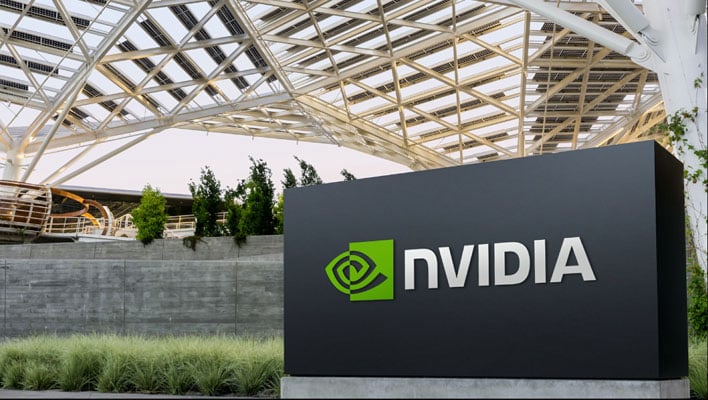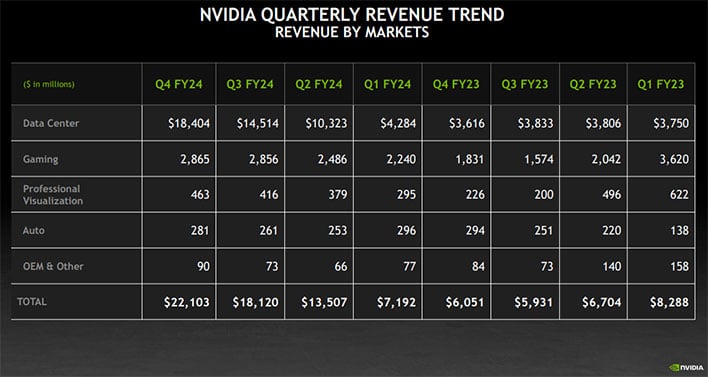NVIDIA Crushes Earnings With Monster Data Center Gains As AI Hits Tipping Point

It wasn’t that long ago when NVIDIA found lightning in a bottle with the cryptocurrency boom, which saw demand for its GPUs skyrocket beyond gaming and into a red hot mining market. Then came the crypto crash and, along with it, concerns about how NVIDIA would bounce back amid sagging GPU sales. NVIDIA found its answer in the data center, and with artificial intelligence emerging as an even more massive market opportunity, the chip designer is cashing in with record gains.
This is reflected once again in its latest earnings report, and no amount of hyperbole can properly underscore what we’re witnessing. NVIDIA posted fiscal fourth quarter revenue of $22.1 billion, which is a sizable 22% gain from the previous quarter and an absolutely monstrous 265% increase from a year ago. And for the full fiscal year, NVIDIA's revenue ballooned 126% to $60.9 billion.
Meanwhile, GAAP earnings per diluted share for the quarter hit $4.93, which is up 765% from a year ago, and for the full year, reached $11.93, up 586% year-over-year.

“Accelerated computing and generative AI have hit the tipping point. Demand is surging worldwide across companies, industries and nations,” said Jensen Huang, founder and CEO of NVIDIA.
That’s putting it mildly. NVIDIA is absolutely killing it in the data center, which raked in $18.4 billion for the quarter for a 27% sequential gain and a 409% year-over-year increase. The strong finish capped off an impressive year that saw the data center contribute more than $47.5 billion to NVIDIA's bottom line, up 217% compared to the previous year.
“Our data center platform is powered by increasingly diverse drivers—demand for data processing, training, and inference from large cloud-service providers and GPU-specialized ones, as well as from enterprise software, and consumer internet companies. Vertical industries—led by auto, financial services and healthcare—are now at a multibillion-dollar level,” Huang added.
The only real unfavorable tidbit to emerge from NVIDIA’s latest earnings is that data center revenue in China fell “significantly” in the fourth quarter, according to CFO Colette Kress. This is attributable to stricter US-imposed sanctions on AI hardware exports to China, as we saw when NVIDIA designed a stripped-down GeForce RTX 4090D specifically for that market.
Even so, NVIDIA is looking like an unstoppable force as demand for AI hardware reaches a fever pitch. What’s unique about this market opportunity compared to the crypto boom is that it’s a market-wide opportunity. Every major technology firm is investing in AI, and NVIDIA has positioned itself to capitalize on the spending spree.
What’s even more exciting for NVIDIA is that this is likely just the beginning, assuming that AI continues to sizzle. AI is still a burgeoning industry, with tentacles that extend into numerous segments.
As a result, the data center is now NVIDIA’s bread and butter, having replaced gaming as its biggest earner. That’s a shift that took place several quarters ago, though what started out as a gap has turned into a gulf.
Be that as it may, gaming is still an important part of NVIDIA’s business. NVIDIA’s fiscal fourth quarter gaming revenue held steady at $2.9 billion, matching the previous quarter and up 56% from a year ago. And for the full year, gaming revenue rose 15% to $10.4 billion.
“NVIDIA RTX, introduced less than six years ago, is now a massive PC platform for generative AI, enjoyed by 100 million gamers and creators. The year ahead will bring major new product cycles with exceptional innovations to help propel our industry forward,” Huang said.
Part of the success in NVIDIA’s gaming business can also be attributed to AI. NVIDIA sees RTX hardware as being key to the shift towards AI-powered PCs, with technologies like Deep Learning Super Sampling (DLSS), AI effects for broadcasters and creators, and so forth. According to NVIDIA, there are now 500 AI-powered RTX games and applications that utilize its technologies.
Looking ahead, NVIDIA noted in its earnings report that it expects to generate $24 billion in revenue (plus or minus 2%) for the first quarter.


